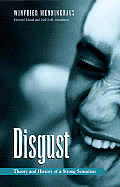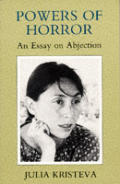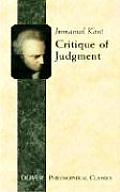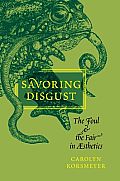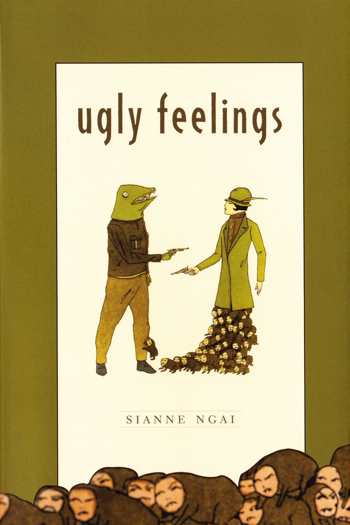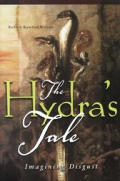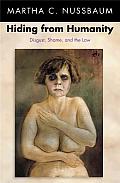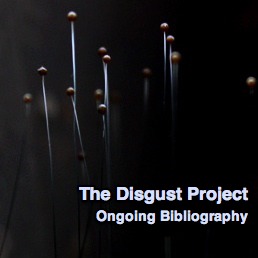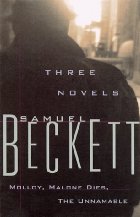
Wow, what happened to the past two weeks? The last thing I remember it was two Sundays ago and I was thinking to myself, "Huh, the next few days will be pretty bus—" and the next thing I knew I was waking up in a ditch by the metaphorical tracks while a bullet train composed of book signings, broken computers, early-morning and late-evening meetings, social calls and looming deadlines, raced past my throbbing head. In the far distance, receding all the time, I could just make out the tiny shapes of overlooked blogging commitments I had passed somewhere along the way.
My commitment, for example, to re-read Beckett's could-be-called-a-Trilogy with blogging friend Anthony, who has by this late date posted his thoughts on both the first and second books. I can barely distinguish this commitment, way back last Wednesday, waving forlornly to me from a distant platform. I knew, though, that I wanted to take my time with this post even if it meant delaying, because Molloy, Malone Dies, and The Unnamable are among those books in my personal canon—the ones which sustain me, which arrived in my life at a key moment and changed my ideas about what's possible in literature and even in life. The ones whose lines and rhythms and bizarrely beautiful narrative voices reverberate in my brain as I go about my days. This, for example:
And I said, with rapture, Here is something I can study all my life, and never understand.
Or this:
And I myself will never lend myself to such a perversion (of the truth), until such time as I am compelled or find it convenient to do so. And I knew this swamp a little, having risked my life in it, cautiously, on several occasions, at a period of my life richer in illusions than the one I am trying to patch together here, I mean richer in certain illusions, in others poorer.
This re-read of Molloy, hurried and fragmented as it was, lived up to all my memories. A two-part, cyclical work, it has the most plot of any of these three books, which incidentally is not very much. We get two sections, both narrated in first-person by two different (but not all that different) men: the first is the ancient Molloy, who recalls his own name with difficulty; the second is Moran, who believes he is an agent sent to track down Molloy. Both men set forth, one after the other, on torturous, convoluted journeys—in many ways the same journey, since Moran attempts to follow in Molloy's footsteps—in which they persevere in spite of mental vagueness and rapid, inexplicable physical deterioration. Both men become obsessed along the way by seemingly irrelevant details—the best manner in which to suck sixteen stones in succession without sucking the same stone twice, for example. In the end both men, somehow, return to what we assume is their beginning point, although in both cases much has changed and this change exceeds their understanding.
This is the classic Beckettian "pointless journey," much like Mercier and Camier and Waiting for Godot. These are journeys in which a character seeks fiercely yet intermittently after something that never appears; something of which the traveler often loses sight or memory, which the reader suspects may not exist in the first place, and which the traveler would probably not reach even if it did.
Yes, I was straining towards those spurious deeps, their lying promise of gravity and peace, from all my old poisons I struggled towards them, safely bound.
I must admit that I find this construct oddly comforting, this idea that the objects of our obsessions are irrelevant to our overall experience—or, if not irrelevant, they are related in ways not immediately obvious, especially as they often go unexamined for long periods of time and our minds and bodies do not cooperate with our stated aims. Molloy knows, although he sometimes forgets, that he is trying to visit his mother: an ostensibly simple task. But he is unable to remember why he wants to visit her; he can barely remember his own name and doesn't recall if hers is the same; he can't ascertain whether the town in which he finds himself is the one where he (and she) live, and he is prone to getting distracted for months or possibly years at a time, being taken in by batty old ladies, or washing up on the seashore for months, perplexed by the stone-sucking dilemma. Likewise, private detective Moran believes that he's pursuing Molloy: a straightforward tail job. However, he's not even sure if his object's name is Molloy or Mollose: most of his "facts" on the case originate in his own imagination; he devotes most of his energy to bullying his son and housekeeper rather than constructing a plan; and in the end none of it matters anyway, as his legs inexplicably become stiffer and stiffer until he can barely move at all, and he abandons the search for Molloy in favor of dispatching his son for a used bicycle. Nothing is accomplished and nothing is known. And yet in the midst of the despair and laughter at this futility there are glimpses of an abiding attachment to human life.
I went on my way, that way of which I knew nothing, qua way, which was nothing more than a surface, bright or dark, smooth or rough, and always dear to me, in spite of all, and the dear sound of that which goes and is gone, with a brief dust, when the weather is dry.
All this is rife with the hilarity and horror of being a) such a rickety contraption as a human, who must b) glean your understanding of the world through flawed sense perceptions, and your reality is moreover c) divorced from standard assumptions about cause, effect, and continuity, but you must nevertheless d) shape your experience into some kind of coherent narrative, or else cease to speak at all. Beckett's work is often called "absurdist," but in my experience it's actually less absurd than most of us might like to believe. Instead, it seems to me an accurate picture of life without the mental filtering mechanisms we use to stay sane. The systems of habit and filtration we use to make sense of our world are so delicate and complex, and can veer off the rails with surprising ease—yet we take them for granted out of necessity, because otherwise even the simplest task would be impossible. We pretend, for example, that we are the same person from moment to moment, when our reality may be more fragmented and unpredictable ("A little dog followed him, a pomeranian I think, but I don't think so."). Or that we perceive the world and then narrate based on what we perceive, rather than creating or half-creating the world via our acts of perception and narration ("I resumed my inspection of the room and was on the point of endowing it with other properties when the valet came back..."). In the absence of these trusty shorthands, the task of communication, even with oneself, becomes daunting.
I felt more or less the same as usual, that is to say, if I may give myself away, so terror-stricken that I was virtually bereft of feeling, not to say of consciousness, and drowned in a deep and merciful torpor shot with brief abominable gleams, I give you my word.
Yet there is something in us which spurs us onward, so that we continue attempting until the very end, despite our inevitable failures and detours along the way. Despite the lack of externally-imposed meaning, and the gaping holes in any system we create to understand the world around us, we are compelled to continue trying, to continue shaping our narratives however we can, incorporating the contradictions and random-seeming obstacles that rise before and within us.
And of myself, all my life, I think I had been going to my mother, with the purpose of establishing our relations on a less precarious footing. And when I was with her, and I often succeeded, I left her without having done anything. And when I was no longer with her I was again on my way to her, hoping to do better next time. And when I appeared to give up and to busy myself with something else, or with nothing at all any more, in reality I was hatching my plans and seeking the way to her house.
Notes on Disgust
(For more information on the disgust project, see here.)
The subject of disgust in this novel would take another long post all on its own, and I have to admit that I often found myself swept away with the beauty and hilarity of Beckett's language to such an extent that I forgot to examine the sections that deal in disgust. They are there, though, and plenty of them. On my first read, I remember being struck by the repugnance of Moran's character, his cruelty to his son, and in particular the scene in which he gives his son an enema. There's also Molloy's allusions to the fact that he may have had sex with his ancient crone of a mother. On top of this is the obvious disintegration of both men's bodies throughout the course of their journeys; Molloy is elderly and Moran appears simply to be inexplicably disabled, but both are falling to pieces, and mixed up sexually and otherwise with other human bodies which are falling to pieces, such as the old whore who may or may not have been Molloy's one experience of "love" (whatever he means by that). At the time she approaches him,
I was bent double over a heap of muck, in the hope of finding something to disgust me for ever with eating...
If I were to hazard a hypothesis on not very careful analysis, it might be that disgust here is something unavoidable which must be accepted, no more or less "meaningful" than anything else in life (unless we make it so) and something which we are all bound to both feel, and to occasion in others. Molloy depicts an undifferentiated world, where questions and observations we normally filter out of our stories and our thoughts (why a person is not a landmark; whether we truly recognize our home towns) instead get dwelt upon compulsively and become ordering principles, substitutes for meaning. As such, the disgusting, which normally dwells in that undifferentiated mass outside normal boundaries, can be found wherever you look and is neither a sign of any particular quality, nor a deterrent to finding meaning there.
And if ever I'm reduced to looking for a meaning to my life, you never can tell, it's in that old mess I'll stick my nose to begin with, the mess of that poor old uniparous whore and myself the last of my foul brood, neither man nor beast.

